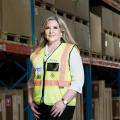The Port of Cape Town experiences a substantial down time owing to adverse weather conditions encountered. In the summer months it is the strong South-Easter (the infamous Cape Doctor) that blows from False Bay through to Cape Town disrupting marine operations; in the winter months, it is the predominant South-South-West/South-Westerly swells that induce delays/suspension of marine operations. Although these weather conditions can be daunting at times, a significant percentage of such interruptions to marine operations can be prevented by deploying suitable crafts and equipment specific to the routine weather patterns encountered in the region.
The average time lost in Cape Town owing to inclement weather is approximately 5 days per month which is huge and amounts to approximately 15% (total time for suspension of marine operations as well as stoppage in cargo operations).
As far as suspension of marine operations is concerned, a substantial period could well be limited, had appropriate crafts been deployed. The nominal swell around the Western Cape is in the range of 2.5m to 3.5m. As per the berthing guidelines of the Port of Cape Town, the stipulated operational limits for pilot boats, whereby these are prevented from venturing out to embark vessels for berthing - is swells ranging between 3m to 3.5m.
At this range the stability of the pilot boat is deemed inadequate, leading to suspension of marine activity. The port is aware of inherent weather issues specific to the region and should have invested in an appropriate pilot boat that’s able to serve the purpose of its functionality. No matter what the weather conditions, pilot boats must always be ready to head out and rendezvous with vessels entering the port. To manage this task proficiently, a pilot boat needs to be stable, reliable and be able to operate in adverse sea conditions, which could be a combination of high waves and heavy swells. Globally it’s unheard of that marine operations are deferred due to limitations of pilot boats.
The deployment of helicopters is a viable option under the circumstances and is being perused by TNPA. Of course there will be a substantial lead time before this option is executed as it’s not only purchasing these crafts, but a suitable helipad must be constructed complemented by a technical workspace for maintenance and repairs, training of pilots, etc.
Secondly the issue of non-availability of tugs of suitable strength has played its fair share in delaying the berthing and sailing of vessels. Cape Town is equipped with three working tugs, two of 39t each and one of 70t bollard pull respectively. This does seem inadequate for the new bigger vessels displayed on this trade. The non-availability of tugs of required capacity restrains the pilots from executing the task in adverse weather conditions, especially during summer time when the South Easters are at their peak. Consequently the jobs undertaken are rather postponed, awaiting return of fair conditions. If there was proper equipment - three powerful tugs - this would certainly induce a sense of comfort, providing that additional reassurance to carry out the assigned job, eliminating any apprehensions that earlier hindered the operations.
The third issue is the surging of vessels within the port of Cape Town which has in addition contributed to operational stand-by times. As compared to a solid quay wall, the Ben Schoeman dock has been constructed on stilts causing the seas within the dock to swirl around the vessels whilst at berth, inducing surging when heavy swells are experienced. To combat this, anti-surging devices need to be deployed along the quay. The automated mooring system, the MoorMaster, consisting of vacuum pads fitted at one of the berths at NCT has proved to be very effective in containing the vessel surges. The disadvantage of this effective equipment is however that it guzzles an enormous amount of electricity, keeping the cost of sustaining it substantially high. Given the present predicament with regard to availability of power, alternate effective devices, vis-à-vis Shore Tension device, can be deployed. The Shore Tension device is quite effective in containing vessel surges, it is cost-effective and consumes negligible electricity. Some terminals have also changed their MoorMaster to the Shore Tension devices. It’s an absolute win-win! Anti-surging devices are designed to effectively combat vessel movements arising out of various external factors. The Shore Tension, in particular, enhances the mooring capabilities of large ships by providing high tension and pays out upon experiencing peaks in load, ensuring the minimum breaking load of the mooring ropes is never exceeded.
For many years shipping lines have been dealing with delays owing to lack of investment in appropriate equipment, which is costing them colossal amounts. For example, let’s work on the impact of delays and the cost implications. The shipping line recompenses the owner, a charter hire, ranging between US$ 25000 to US$ 40000 per day, regardless of whether the vessel has been engaged in cargo operations or is awaiting a berth at anchorage.
This delay in berthing or sailing implies that the berthing windows in the subsequent ports are jeopardised, which induces further delays in berthing, which will be afforded, subject to availability.
In addition the vessel will now have to steam at full speed instead of economical, burning additional fuel bunkers. Over a distance of 5000nm (10 days at full speed @ 21 knots), the additional fuel expended is approximately 300 MT costing approximately US$ 130 000.
If recovery in schedule is not made, shipping lines look at the option of skipping ports. This implies that the cargoes destined for a particular port/s has to be discharged elsewhere and transhipped back to the original port of destination.
Likewise, the containers intended for export out of the port that is omitted must be shipped from another port. Considering an additional exchange of 1000 units to be transhipped (both imports and exports) at an average cost of US$ 150 per unit, an additional spend of US$ 150 000 is necessitated for transhipment alone. This excludes the sea freight.
Furthermore, if the schedule recovery is not possible, another vessel will be required to be hired and injected into service in order to maintain a weekly service as is the case with liner trades. As elucidated, the effect of a small delay in one port has a multiplier effect, having huge cost implications, and there seems to be a disconnect in understanding the price a shipping line may have to pay as a consequence.
It’s about time, emphasis is laid on the efficiencies within the port system to grow the economy of the country. South Africa is geographically strategically placed on the global map to lure gigantic trade volumes, amidst other marine-related activities. It’s distressing that a country that has so much potential is abstaining from promoting its credentials. If mere efficacies within the port system were demonstrated, huge additional volumes could be drawn, presenting South Africa to the world as a prime transhipment hub, which would create much-needed additional jobs. The ports could serve as a major distribution centre for the East and West African regions for cargoes arriving from Europe, Far East Asia, Middle East, India/Pakistan, USA, South America, Australia, New Zealand and vice versa. Our ports are world-class with state-of-the-art equipment comparable to any other developed ports of the world.
The inducement of efficiencies is the gateway to generation of employment for the youth of the country who seek these opportunities, thus facilitating social upliftment. Most certainly, there has been a lack of responsible execution and little understanding of the impact on the innocent unemployed to whom an apology is owed.









